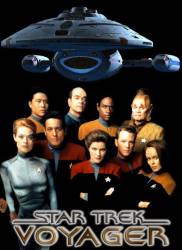Factual error: Chakotay says "if our orbit starts to decay, Voyager will begin to feel the effects of the differential, and we'll begin aging hundreds of times faster than we would in normal space". Whilst it is true that they would be aging faster relative to normal space, they would not instantly become old. Time would simply slow around them, so whilst they would be aging faster relative to normal space, they would not all of a sudden become really old - which is how it is made out to be. They would all age the same amount whether in a standard orbit or in a more decayed orbit. (00:06:37)
Suggested correction: There is nothing incorrect about what he said. They will start ageing hundreds of times faster than in normal space.
Aging implies getting/feeling older. They'd only be "aging" relative to normal space. What would happen would be more akin to time travel, with the universe getting older around them.
But the point is, they wouldn't age faster just because "normal" time slows down. If they spent a year on the planet, they'd age 1 year, not 100 years.
Plot hole: When orbiting the planet, Seven says that for every second on Voyager, nearly a day passes on the planet and later Janeway says 3 seconds is nearly 2 days. However, throughout the episode, time seems to move much faster on the planet to fit the plot. It would take more than 6 days for 1,000 years to pass. And in a few hours (3) less than 20 years would pass (hardly enough time for the rise and fall of a civilization). For example, when they receive the transmission, they slow it down and immediately start playing it. The next scene the senior officers are listening to it and the Doctor says nearly a century has passed, but there's no reason (or indication) that they waited almost 15 hours to listen to it.
Revealing mistake: If you look closely at the hot air balloon, in the shot before the message is attached to it, you can just see a wire holding it up.





